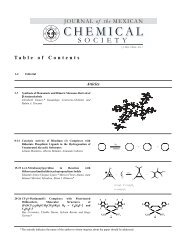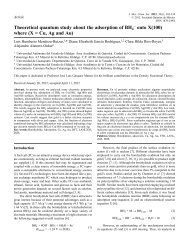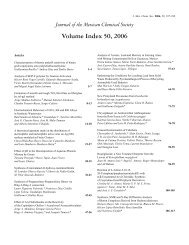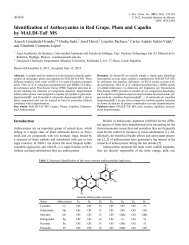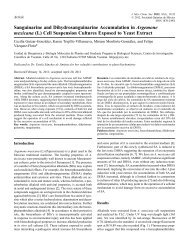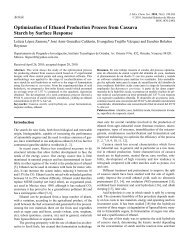Pincer Complexes. Applications in Catalysis
Pincer Complexes. Applications in Catalysis
Pincer Complexes. Applications in Catalysis
Create successful ePaper yourself
Turn your PDF publications into a flip-book with our unique Google optimized e-Paper software.
344 Rev. Soc. Quím. Méx. 2004, 48 David Morales-Morales<br />
Recent advances<br />
As it can be noted from the above, the p<strong>in</strong>cer ligands an their<br />
metallic derivatives represent <strong>in</strong> many cases the ideal examples<br />
to carry out catalytic processes otherwise difficult or<br />
impossible to be carried out with conventional diphosph<strong>in</strong>e<br />
ligands. The versatility of these species to be modified and<br />
modulated both steric and electronically, makes these compounds<br />
an their correspond<strong>in</strong>g transition metal derivatives<br />
attractive complexes to be cont<strong>in</strong>uously used <strong>in</strong> different challeng<strong>in</strong>g<br />
catalytic processes. Thus, around the world several<br />
important research groups ma<strong>in</strong>ta<strong>in</strong> as priority research l<strong>in</strong>es<br />
the design of new p<strong>in</strong>cer ligands, their complexes and their<br />
potential applications, while other research groups have foreseen<br />
the potential of these complexes by use them as catalyst<br />
<strong>in</strong> different organic transformations. It is noteworthy the use<br />
of the palladium–phosph<strong>in</strong>ito PCP p<strong>in</strong>cer complex 27 [39] <strong>in</strong><br />
the synthesis of corannulenes <strong>in</strong> high yields recently reported<br />
by Siegel and coworkers [40].<br />
Moreover, Zsabó and coworkers [41] have found the palladium<br />
derivatives of NCN and PCP p<strong>in</strong>cer complexes to be<br />
active catalysts <strong>in</strong> the allylic stannylation reaction with high<br />
yields.<br />
Recently, Morales-Morales and coworkers have extended<br />
the application of the iridium p<strong>in</strong>cer complexes IrH 2{C 6H 3-<br />
2,6-(CH 2PR 2) 2} (R= Bu t , Pr i ) for their application <strong>in</strong> the catalytic<br />
dehydrogenation of am<strong>in</strong>e [42] and alcohols [43], provid<strong>in</strong>g<br />
alternative high yield methods for the synthesis of<br />
im<strong>in</strong>es and ketones and aldehydes.<br />
Additionally, Goldman et. al [44] has recently reported<br />
the use of these same species for the catalytic dehydrogenation<br />
of tertiary am<strong>in</strong>es to enam<strong>in</strong>es <strong>in</strong> good yields.<br />
Furthermore, Brookhart et al. [45] and Morales-Morales<br />
et al [46] have recently reported, <strong>in</strong>dependently, the use of<br />
Iridium-Phosph<strong>in</strong>ito PCP p<strong>in</strong>cer type complexes <strong>in</strong> the catalytic<br />
dehydrogenation of alkanes, thus match<strong>in</strong>g the yields and<br />
performance of the previously reported phosph<strong>in</strong>o analogues.<br />
However, these complexes exhibit additional advantages compared<br />
to their phosph<strong>in</strong>o counterparts, such as the fact that the<br />
phosph<strong>in</strong>ito PCP p<strong>in</strong>cer ligands can be obta<strong>in</strong>ed <strong>in</strong> an easier<br />
manner and <strong>in</strong> higher yields; and, second, that the hydrido<br />
species are not necessary, s<strong>in</strong>ce this complex can be formed <strong>in</strong><br />
situ by pla<strong>in</strong> addition of a strong base, like NaOBu t .<br />
The cont<strong>in</strong>uous search for more specific ligands [47], has<br />
taken several research groups to the synthesis of more complex<br />
ligands as well as their transition metal complexes, with<br />
more elaborated structures <strong>in</strong>clud<strong>in</strong>g fullerene (28) [48] or ferrocene<br />
(29) [49] backbones or very sterically h<strong>in</strong>dered ligands<br />
(30) that have allowed to block, <strong>in</strong> a very specific way, partic-






